Don't wanna be here? Send us removal request.
Text
A Holistic Review of the Russian Ark
Wendy Ducas
May 4th, 2021
CMS 294
Christian Vukasovich
Assignment 7: Russian Ark
Personal Perspective
After watching this movie, I was intrigued and also left with a few questions, but not enough so that I was completely lost. I absolutely loved the way that the film was shot, this was the first movie I’ve seen where it was shot from one of the characters perspectives, and it was interesting to see why they used it for this piece. There were times where I would get a little lost with the events of the movie and how it all connected, but at the end of the film, I wanted to know more about what was going on and how I could find out more. Overall, an initial reaction to the film might be one that is negative if one is confused about the events or the topics discussed in it.
Historical Perspective
Russian Ark was filmed in 2001 and made in 2002. The film took two years of preparation before Alexander Sokurov could put it into action. Also in Russian filmmaking, two other movies were filmed at the Hermitage recounting events from Russian history. The Peacock Clock, by Sergei Eisenstein and, The End of St. Petersburg, by Pudovkin were both filmed within the Heritage and recalled historical events of Russia during the 18th and 19th centuries. The difference between these films and Russian Ark was in their use of editing and avant garde style. Russian Ark completely strays from this popular style in Russian filmmaking, with its one shot take and complete lack of editing, which ultimately worked in its favor (The Guardian).
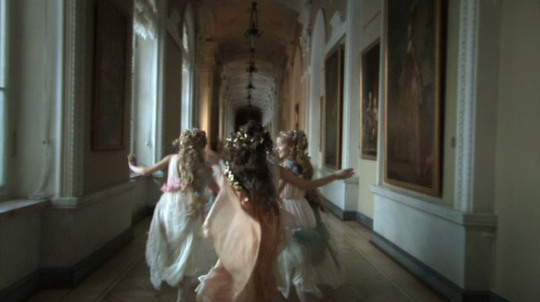
Source: http://www.sevencut.com/july-2017-patriotism-month/2017/7/24/patriot-month-7-russian-ark-by-alexander-sokurov-2002
Technological Perspective
The movie is made up of one continuous, hour and a half, shot. Even though the film captures history before the invention of color film, color is still used to give an accurate representation of what everything looked like back in the day. The entire project was filmed in a single day, the shortest day of the year, December 23, 2001. To help make this possible, Sokurov used a high definition Sony steadicam that could hold up to 100 minutes of footage nicknamed, “The Director’s Friend” (Shields).
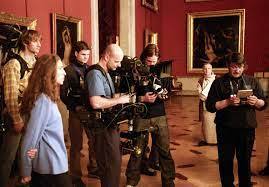
Source: https://www.trigon-film.org/en/movies/Russian_Ark
Supplementary lighting was used based on a detailed system made by the film’s cinematographer, Tilman Büttner. To even make this movie possible, there were several teams that moved throughout the museum as filming was taking place. One team moved ahead of the camera to make sure everyone and everything was ready, and perform quick scene changes if necessary, and a second sweep team followed the camera to make sure everyone was ok after their scene.
Ethical Perspective
From an ethical viewpoint, there’s not much this film challenges. There’s no use of violence and no smoking, but the one line that the film might cross is stereotypes. The one character that we see interacting with us throughout the film is the European. As we traverse throughout the Hermitage, we’re accompanied by a character not from Russia, but noted at by the narrator as a European. The European interacts with those stuck in time, past and present, but has a few questionable encounters with some of the women he comes across. This character might be an overgeneralized stereotype of all Europeans, especially considering that if one were to go with stereotypes, the French are the ones to woo other people. In thinking about and discussing stereotypes in this film, one has to keep in mind that this film is entirely from a Russian point of view, so the stereotypes of others that may be included in it are those of the Russians.

Source: Screenshot from film
Cultural Perspective
The film’s genre is one that can be categorized as a mix of things. You could say that it’s a documentary of sorts, but only in the sense that it discusses and tells the story of certain periods in Russian history. It mentions certain aspects of war, but it wouldn’t be considered a war film. Along with that, it also has a separate narrative that isn’t historical or factual, but helps to move the overall narrative throughout the film. To actually classify this movie into a specific genre, most would say that it’s an experimental historical drama.
Critical Perspective
To make a movie in this style would be extremely difficult and take a lot of time and resources to pull off in a way that filmmakers would see as worthwhile. The Russian Ark was able to successfully do this because of their planning and the people on the team who organized and put everything together. The film itself gives a lot of historical information about Russia in the 18th and 19th centuries, even though it’s not a documentary per se. People see this film as a miracle in itself because of what they were able to accomplish given their time constraints, their equipment, and the overall complexity of the project. No one else has been able to successfully create a project of this manner in the way that Alexander Sokurov has, and people are alright with it staying that way.
Sources:
The Guardian. "90 Minutes That Shook the World." The Guardian. Guardian News and Media, 28 Mar. 2003. Web. 01 May 2021.
Shields, Meg. "How They Shot 'Russian Ark' in One Long Take With No Hidden Cuts." Film School Rejects. 16 Nov. 2020. Web. 01 May 2021.
1 note
·
View note
Photo
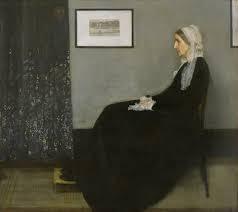
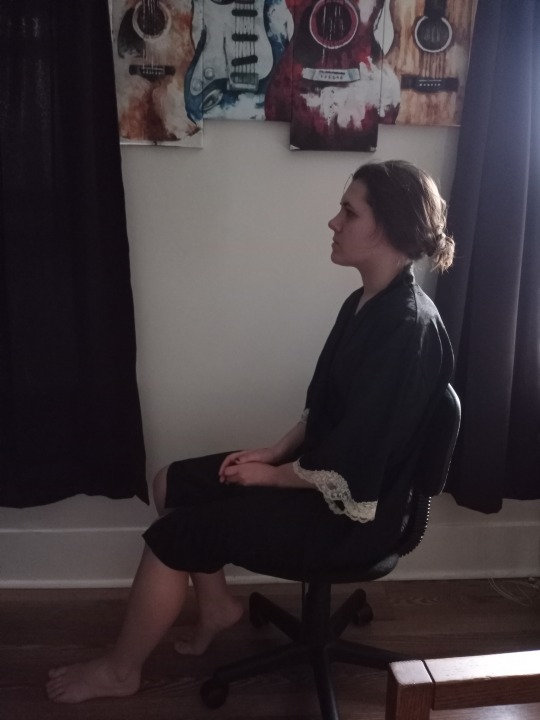
Personal Perspective
This image is set up and not an in-the-moment snapshot. The pose of the subject isn't one that's entirely natural, either. At first glance it appears to be a parody of the original image with no other meaning behind it.
Historical Perspective
The original painting the recreation is based off of was made by James Abbott McNeill Whistler. The painting, "Whistler's Mother," is true to its name in that she was the model for the portrait. This painting is known for the dark colors presented in the image and the way his mother is posed. Combined it serves as a symbol for grieving and mourning a loss.
Technological Perspective
The photo was taken with a Samsung Galaxy A21 cell phone. No flash was used, and the photo was taken with a 3:4 ratio. The image heavily relies on the natural lighting in the room, and the lack of light caused by the closed curtain on the left. No lighting equipment was used.
Ethical Perspective
This image can be seen from a categorical imperative point of view, it may not serve any other purpose than documenting a time in history from a very personal perspective. It’s a widely shared perspective, and it may not look the same as everyone else’s during this time, but it’s similar to the vast majority in aspects of it that it can be seen as a good representation of what people went through during the pandemic.
Cultural Perspective
The use of symbolism in this image shows a representation of life during the Covid 19 pandemic. The use of a desk chair instead of one used in the original painting is a sign to how almost everything in life transferred to an online medium. The change from the long dress and bonnet to a robe and messy hair pays homage to how people's clothing habits changed during the pandemic. People weren't going anywhere and were locked up in their homes, so people's everyday wear changed from casual clothes to sweat pants and pjs. In the original painting, Whistler uses dark colors to symbolize grieving and mourning, in this image the dark lighting goes to stand in for that, and also stands for the major loss of time and life during the pandemic. In addition to that, the light coming in contrasts the dark, in lighting and meaning. While the person is facing the dark, toward loss and grief and mourning of what has been lost during this time, the light that's coming in behind her shows that there is hope, but she may just need a minute or two longer in mourning before she can turn around and pick life back up again.
Critical Perspective
At first glance, this image might look like a parody of the original as you’re passing by, but an analysis of it shows the historical allusions it gives clues to. A closer study shows little bits and pieces that lead to individual aspects of what life was like during the pandemic of 2020, but put together they give way to some of the thoughts that individuals may have had throughout the year. Overall, this image may look like a simple recreation, but through a total analysis, tells the narrative of life during a global pandemic.
Sources:
https://www.newyorker.com/magazine/2015/08/31/moms-home
https://totallyhistory.com/whistlers-mother/
0 notes
Photo
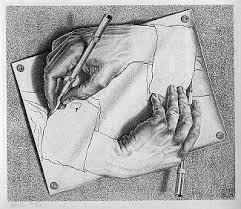
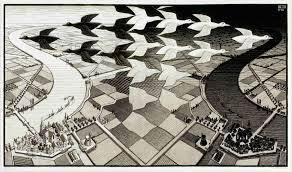
M.C. Escher’s work was not only known by mathematical theorists for the rules that it made and broke, but it’s also known for the intriguing combination of many aspects of art that created viewpoints that had never been seen before. Escher’s use of shape and depth explored the possibilities that could be offered through different perspectives, whether that was through different perspectives in the same image, or by creating a perspective so far from the norm that it forced the viewer to see things they usually wouldn’t. For this analysis, I’ll be exploring these ideas through his 1984 piece, Drawing Hands, and his 1938 piece, Day and Night.
In Drawing Hands, we see an image of two hands springing to life from a page, assisting each other in completing the artwork of the other. The interesting thing about this image is the transition from the 2D space of normal drawings, to the level of depth and volume in the 3D portions of the page. If you separate the 2D and 3D portions of the image, Escher’s use of depth helps clearly define them on their own, but when you look at the image as a whole, the contrasting levels of depth help to make the image look like it’s all within the same plane. “In Drawing Hands, space and the flat plane coexist, each born from and returning to the other, the black magic of the artistic illusion made creepily manifest.” (Poole)
In Day and Night, what you might see at first is a flock of birds flying over a normal looking city, but looking at it closer, you can see that the two are seemingly morphing into and creating one another. In the previous image, Escher plays with the sense of depth and how it interacts on a singular plane, but in this image he plays with the use of shapes on different parts of a plane to create different effects. By changing the shape of the field squares and the almost-triangle like shape of the birds in flight, he creates a transition in the scene from one time of day to another and causes, “ the distinction between foreground and background [to be] obliterated: the viewer can choose to see one or other set of shapes as foreground at will.” (Poole)
These two images are only small examples of Escher’s work throughout his life and only a small portion of the way he uses depth and shape to create and change perspectives of a viewer. Not only was he able to influence the way a viewer saw something, he was also able to keep their attention for longer because of the challenging perspective they were being presented with.
Citations
Poole, Steven. "The Impossible World of MC Escher." 20 June 2015. Web. 12 Feb. 2021.
0 notes
Photo
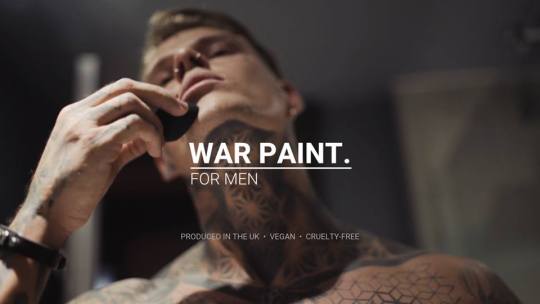



One of the most obvious and subtle ways that gendered stereotypes are perpetuated to the masses through the media is with advertisements specifically for a product. It’s one of the most obvious because it can suggest things that are extremely based on stereotypes, which then cause an uproar in the public and a damage in the sales of that company (not always the case, but can largely be the case). It’s also one of the most subtle ways because it can instill such stereotypes into people in the first place if you’re not careful about what you see. We can see this in the plethora of advertisements that are using such stereotypes as reasoning for people to go and buy said products. The problem with doing this is that it’s teaching and reinforcing said stereotypes, which are often based on malicious opinion, and are nowhere close to the actual truth.
In the first image we see a classic case of toxic masculinity reclaiming something as its own. The makeup brand War Paint advertises itself as a male makeup line. Now, there’s nothing insanely wrong or upsetting about that per say, but the way that this brand goes about doing it is. They completely focus the image and brand of their makeup line around violence. With a name like “War Paint,” what other reason could they have for marketing it in such a way, except to separate it from every other makeup line that could be perceived as “feminine” or “gay?” Ash Griffith, a writer from RVA magazine, also questions this brands marketing technique for the same exact reason: “the biggest thing the potential customer base for overtly masculine lines like this are terrified of is the possibility that they will be perceived as gay if they touch or use anything traditionally feminine.”
While toxic masculinity tries to steer men away from certain things in the first image, it attempts to encourage men to do things in the second one. What I mean by this is, the first image discourages men from using makeup as it isn’t “masculine” enough unless they use brands that market themselves that way like War Paint does. In the second image, however, it encourages men to do things that are considered masculine by the standards of toxic masculinity.
The second image reinforces the idea that it’s more acceptable to cheat on your partner than it is to miss working out. This idea shows support toward two masculine stereotypes. The first masculine stereotype the image supports is that it’s acceptable and almost ok for men to cheat on their partners. By talking about it in such a casual manner and in a seemingly positive way, it reinforces this stereotype and basically encourages it to others. The second masculine stereotype the image supports is that you have to work out or should be working out no matter what. This is a pretty harmful stereotype, and has been forced and encouraged onto others in similar ways as this image does. The image tells others to focus on their commitment to working out over their commitment to a partner they may have, so much so that it doesn’t matter if you cheat on your partner because at least you’re committed to your workout routine.
In the third image we see a perfect example of the housewife stereotype. It reinforces this stereotype because it treats women as objects that are only used for specific tasks, more specifically, ones dealing with household management. This stereotype is extremely limiting to women, and perpetuates the idea that they aren’t useful unless they are taking care of the home or pleasing their “man.” We also see that case in the image as well, with the women holding onto the back of the man. There’s also an instance of toxic masculinity in the image as well. It’s a bit small to see, but in the bottom right corner above the name of the brand is the words, “I’m getting my wife a Kenwood Chef.” This supports the stereotype that men can’t, or more “shouldn’t,” be the ones cooking in the household, and that the only people that can use this product are women.
Finally, in the fourth image we see the use of a woman’s body to promote the sale of alcohol, and to perpetuate the idea that if a man obtains x, y, and z, then they can ultimately get any girl they want. This image completely dehumanizes the woman by just showing her from the waist down, and turned away from the point of view toward the man. It shows her as nothing more than an object, which is used to entice people (specifically male audiences) to buy, and as a type of “reward” (for once again, a male audience) to whoever buys and uses the product.
Sources: https://rvamag.com/gay-rva/just-wear-the-damn-lipstick-already.html
1 note
·
View note